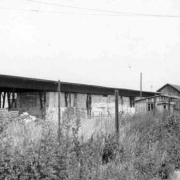Satellite Camp Saurerwerke
Establishment of the satellite camp
As of 20 August 1944, the “Saurerwerke Subcamp” (also called Saurer-Werke and “Wien-West”) was established in Vienna’s district of Simmering (11th district). The first transport brought around 140 prisoners, who were accommodated in a barracks camp at the gates of the factory premises, which had been used for civilian detainees and POWs before.
Location
The Saurerwerke factory halls were located in Haidestraße 22/Oriongasse in the 11th district. They still exist to this day. The former factory premises are used by the LGV Frischgemüse Wien reg. Gen.m.b.H. who have also added new buildings
Prisoners
During the first month of its existence, the number of prisoners at Saurerwerke Subcamp increased from 150 to 1,000; another two months later, there were 1,391 people detained at the camp. In late February and early March 1945, the highest number of prisoners was reached with 1,480 people. Most of the men were categorised as “political” prisoners. They were from Germany, France, Greece, Italy, Yugoslavia, Austria, the Netherlands, Belgium, Spain, Luxembourg, Poland, the Soviet Union, Czechoslovakia, and Hungary; there were also several Jewish prisoners among them. Camp Senior was Franz Kalteis from Vienna, who had been sent to Simmering from Mauthausen upon initiative of the illegal resistance organisation of prisoners at the concentration camp. At the Saurerwerke, too, an illegal prisoners’ organisation formed, consisting of representatives of all nations and (political) courses of the camp. It was built up and headed by Walter Ehlen (functionary of the German Communist Youth Association).
Forced labor
The Saurerwerke had specialised in track vehicles and trucks before the Anschluss (annexation of Austria into Nazi Germany), and they continued their production under the Nazi regime. The prisoners were only used for the production of tank transporter trucks. They worked in the C hall in Werk 2 (the windows had been barred there, and extra walls built). Since the factory premises had become too small, two large halls in the basement of the nearby Neugebäude castle were also used as production halls until March 1945. Survivors later reported that they often experienced shows of solidarity from civilian Austrian and foreign workers. Apart from that, however, working conditions were harsh. 40 prisoners died at the camp. Another 17 lost their lives in the “infirmary camp” after they were brought back to Mauthausen Stalag.
Guarding
SS-Hauptsturmführer (Chief Assault Leader) Johann Gärtner was camp commander; SS-Oberscharführer (Senior Squad Leader) Karl Kleine headed the protective custody prisoner camp, and SS-Oberscharführer Gerhard Wittkowski was leader on duty. Four SS officers from Mauthausen, 46 SS sergeants, and 85 SS crew members were in charge of guarding the prisoners.
Closure
On 1 April 1945, preparations for evacuating the Saurerwerke camp started. Camp Senior Franz Kalteis managed to dissuade SS-Hauptsturmführer Gärnter from killing the 190 prisoners who were sick or “unable to march” and instead to leave them at the camp. The following day, 1,276 prisoners were sent on an evacuation march in three columns. From Simmering, they walked through Purkersdorf, St. Pölten, Man, Scheibbs, Gresten, Randegg, and Seitenstetten all the way to Steyr. Many prisoners were shot by the SS during the march, and several died from exhaustion. 25 prisoners managed to escape. On 23 April 1945, 1,076 prisoners arrived at Steyr-Münichholz Subcamp. One week later, on 30 April, 497 of them were transferred to Mauthausen Stalag. Those who had been “unable to march” and left in Simmering, were liberated by Soviet troops on 8 April 1945.
Commemoration and remembrance
Upon initiative of the SPÖ district administration Wien-Simmering, a monument was erected a couple hundred metres to the east of the premises of the former subcamp in 1981. It is the site of an annual commemoration celebration organised by the Verein Niemals Vergessen [1], whose members are also active within the network of the Mauthausen Committee Austria. The “Bund Sozialdemokratischer Freiheitskämpfer/innen, Opfer des Faschismus und aktiver Antifaschist/inn/en” (Association of social democratic freedom fighters, victims of Fascism, and active Antifascists), the Mauthausen Committee Austria, and the local school for the hospitality sector participate in the yearly celebration. The programme for commemoration celebrations can be found on the website of the Mauthausen Committee Austria [2].









